
Résumé
An innovative hydrogen test area for cryogenic high-pressure applications has been put into operation at the ILK Dresden. This test area allows fundamental investigations on hydrogen (in all its phase states) and on gaseous helium. Furthermore, tests and qualification of components of any kind in the temperature range from room temperature down to 10 K and under pressure conditions ranging from high vacuum to 1000 bar are possible. In the framework of a research project, investigations of the charging and discharging process of hydrogen tanks, and the development of new storage technologies to achieve a high hydrogen storage density up to 100 kg/m³ are feasible. Our experiments promote the intricate developments of new components in relation to the handling of supercritical mediums. Thereby, experiments on re-cooling systems in form of capillary expander or Joule-Thomson-cooler are performed as well as on special latent-heat storage systems based on eutectic mixtures. The current status of the development up to test set-ups and experimental results is presented. Furthermore, results of numerical calculations are shown regarding the optimization of process control.
Documents disponibles
Format PDF
Pages : 289-294
Disponible
Prix public
20 €
Prix membre*
Gratuit
* meilleur tarif applicable selon le type d'adhésion (voir le détail des avantages des adhésions individuelles et collectives)
Détails
- Titre original : A new cryogenic high-pressure H2 test area: first results.
- Identifiant de la fiche : 30006695
- Langues : Anglais
- Source : Cryogenics 2012. Proceedings of the 12th IIR International Conference: Dresden, Germany, September 11-14, 2012.
- Date d'édition : 11/09/2012
Liens
Voir d'autres communications du même compte rendu (78)
Voir le compte rendu de la conférence
Indexation
- Thèmes : Transport et manipulation des fluides cryogéniques
- Mots-clés : Joule-Thomson; Stockage; Hydrogène; Haute pression; Experimentation; Essai; Cryorefroidisseur; Cryogénie
-
Heat transfer characteristics of heat exchanger...
- Auteurs : HONG Y. J., PARK S. J., CHOI Y. D.
- Date : 17/07/2006
- Langues : Anglais
- Source : Multiconference CryoPrague 2006 (9th Cryogenics 2006, ICEC 21, ICMC'06)
- Formats : PDF
Voir la fiche
-
Unsteady modeling of Taconis oscillations.
- Auteurs : MATVEEV K. I.
- Date : 07/04/2025
- Langues : Anglais
- Source : Cryogenics 2025. Proceedings of the 18th IIR International Conference on Cryogenics, Prague, Czech Republic, 7-11 April 2025.
- Formats : PDF
Voir la fiche
-
Experimental study for improving measurement ac...
- Auteurs : HAN S. M., AHN J. S., HEO J. Y.
- Date : 07/04/2025
- Langues : Anglais
- Source : Cryogenics 2025. Proceedings of the 18th IIR International Conference on Cryogenics, Prague, Czech Republic, 7-11 April 2025.
- Formats : PDF
Voir la fiche
-
Integration of a photoconductive detector with ...
- Auteurs : BHATIA R. S., MURRAY A. G., GRIFFIN M. J., ADE P. A. R., BRADSHAW T. W., ORLOWSKA A. H.
- Date : 25/06/1996
- Langues : Anglais
- Source : Cryocoolers 9. Proceedings of the International Cryocooler Conference.
Voir la fiche
-
Experimental study on emissivity measurement of...
- Auteurs : HEO J. Y.
- Date : 07/04/2025
- Langues : Anglais
- Source : Cryogenics 2025. Proceedings of the 18th IIR International Conference on Cryogenics, Prague, Czech Republic, 7-11 April 2025.
- Formats : PDF
Voir la fiche
